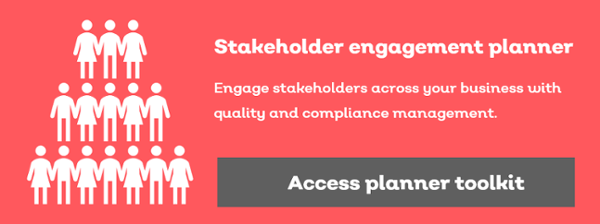Want to contribute to this article?
At the CQI Conference 2016, Alex Woods, Professional Networks Manager at the CQI, hosted a workshop with a panel of ISO 9001 experts to discuss how the revised standard will deliver value.
Over half of the quality professionals in the session said that the revised clause 5, 'Leadership', was the most significant and challenging. Drawing on this theme, we've summarised 3 key lessons and tips mentioned in this workshop for better engaging leadership with quality.

1) Raise awareness of your cause
Many of the delegates expressed concerns about getting leadership to take a more 'hands-on' approach to quality.
Keith Snell, a quality professional at Virgin Trains and one of the delegates at the CQI Conference, suggested that one of the reasons could be a lack of awareness. He shared an initiative he'd employed to get leadership buy-in.
Keith said: "We posed 15 to 20 questions to senior managers, in an environment where they wouldn't need to show their responses to an auditor. They then had to go away and answer the questions, providing evidence to support their answers. This gave the leadership team an opportunity to really understand what we're trying to achieve. Within weeks, they bought into quality. It was a very good starting point."
If getting leadership to take a more hands-on approach to quality is one of your challenges, try using a quiz devised by Peter Pond, Quality Manager at Qualsys. We've designed the quiz to improve stakeholder engagement with quality at all levels of the organisation, and you can easily adapt it to suit your own specific requirements.
Download the ISO 9001:2015 Toolkit for a quality management quiz
2) Look at the shop floor to see leadership's impact
Essential to the revised standard is that top management demonstrate a 'hands-on' approach with respect to their quality management system.
Jeff Ruddle, Operations Director at UKAS, suggested that there's an opportunity to understand how well leadership is performing by looking at the processes and systems at an operational level.
"It is useful to go out into the organisation and look for evidence of whether leadership's message is coming out of the boardroom," Jeff said. "You can see whether there are benefits and if leaders are making positive changes to the way the organisation operates. This is a very effective way to see if the leadership clause is being appropriately met."

One way to review performance at an operational level is to use iEQMS, a mobile application for audits and inspections. Configured to meet your requirements, the app gives you much greater visibility into operational performance when carrying out an audit.
3) Incentivise a commitment to quality
A report by Harvard Business Review found that multinational companies with highly developed quality cultures spend, on average, £238 million per year less fixing mistakes than companies with poorly developed ones.
Despite the evident cost savings of those highly developed cultures, many of the quality professionals at the CQI Conference expressed concerns that their management weren't as involved with quality improvement practices as they could be.
Mark Braham, Head of Business Assurance for the Automobile Association, who also contributed to writing the ISO 9001:2015 standard, discussed how incentivising top management to take control over quality assurance has led to positive results.
"If you have a targetable objective, you are more likely to succeed," Mark said. "For most board members, I've got 5% of their annual bonus. If they don't perform, I can withdraw that bonus. It has a really positive effect on driving the right behaviour. Quality assurance is now bread and butter to them. Leadership do it day in and day out and look at performance all the time. They now bring a quality assurance agenda to every meeting."
Victor Vroom, a business school professor at the Yale School of Management, developed the Expectancy Theory of Motivation in 1964. The theory emphasises the need for organisations to relate rewards directly to performance and to ensure that the rewards they provide are the ones the recipients want and deserve.
Whether it's a financial reward, recognition or a reward of some other kind, how can you incentivise management to take more control over their quality responsibilities?
One option could be to use EQMS Issue Manager to get greater visibility over problems, complaints and incidents, measure the costs of non-conformance and improve proactive management.
Download our datasheets for more information on EQMS Issue Manager
What you should do now
Download our Stakeholder Engagement Planner for a step-by-step guide to driving engagement with quality.









Share your thoughts on this article